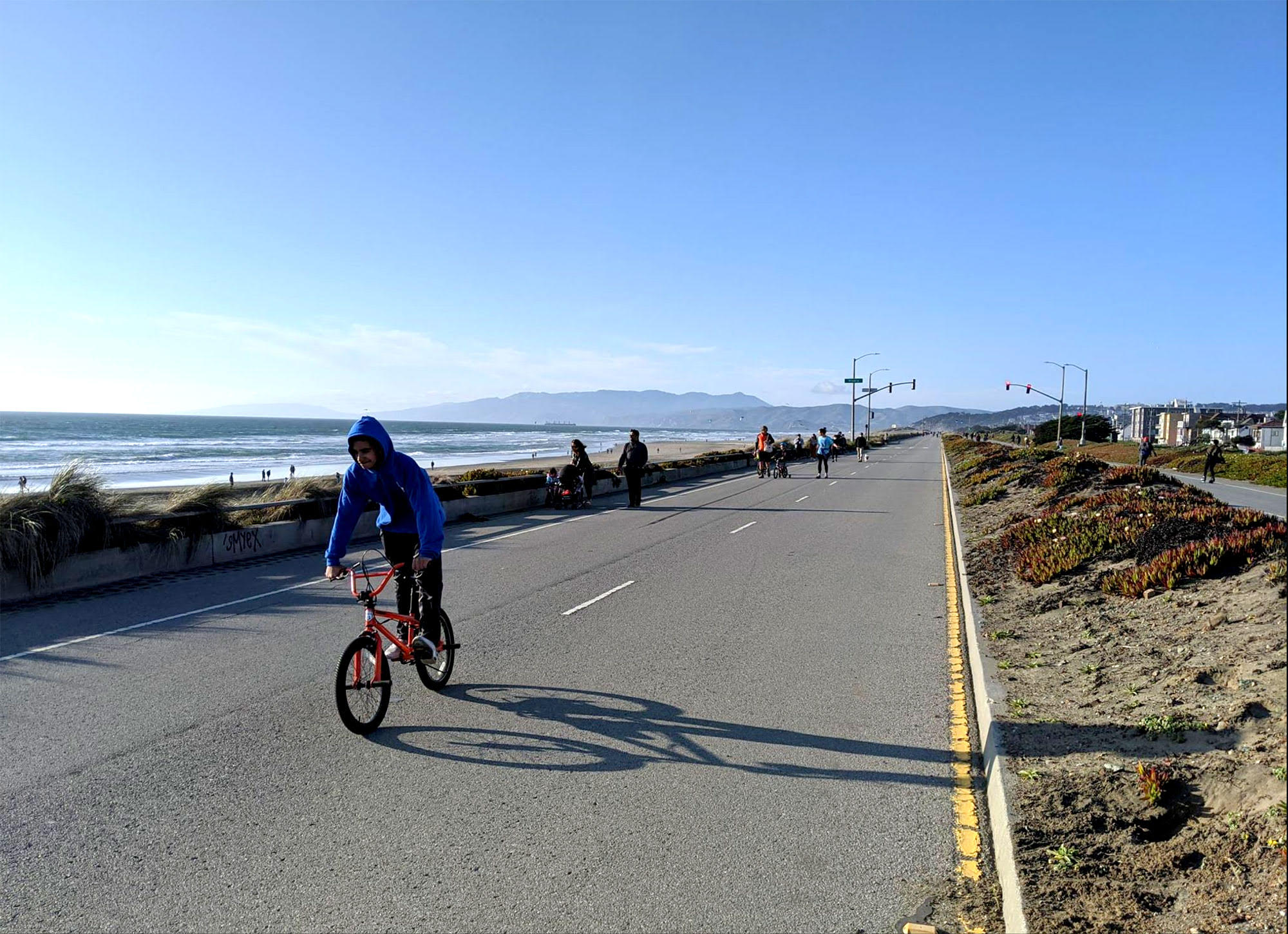Note: GJEL Accident Attorneys regularly sponsors coverage on Streetsblog San Francisco and Streetsblog California. Unless noted in the story, GJEL Accident Attorneys is not consulted for the content or editorial direction of the sponsored content.
The Great Highway and Point Lobos Avenue have revealed a sharp contrasts in what the post COVID-19 future might look like for city streets. One of those futures looks a lot like the past: car drivers get all the space and other road users just fight over scraps. But in the other, the streets belong to the people and must be safe and inviting to all users--even if that means restricting motorists.
First, the Great Highway between Sloat and Lincoln, which was closed for the COVID-19 crisis (and because sand needed to be cleared). As the video from safe-streets advocate Matt Brezina shows below, people were out in droves Sunday riding and walking and enjoying a safe environment by the beach, all while maintaining safe social distance.
If you have not visited this incredible new pedestrian promenade for some physically distanced exercise, I HIGHLY recommend you do. The car noise is gone. The fear of car violence is gone. People of all ages and abilities are out exercising. You can hear the waves. It’s GLORIOUS! pic.twitter.com/h9xJC6B5GH
— Brezina 🇺🇦 🌳👧🏼👶🏽🌳 (@brezina) May 18, 2020
Glorious indeed.
"A former car highway that has been repurposed for people to walk, stroll, bike and roll. One of San Francisco's grand new parks at two miles long and 60 feet wide, I've calculated it is over 15 acres," continued Brezina, in an email to Streetsblog. "And this is managed by San Francisco Recreation & Parks. This is park land already!"
In other words, the city doesn't have to negotiate with a golf course or the federal government to make changes. This is on them.
Streetsblog reached out to Supervisor Gordon Mar, who in April pushed to have this stretch of the Great Highway kept closed during the COVID-19 crisis. Streetsblog asked if he would support making this permanent and will update this post.
That said, all is not well on the Great Highway.
At least not where cars are still permitted, as it transitions into Point Lobos Avenue and climbs up to the Cliff House. On this stretch, drivers showed their disregard for the safety of others, as referenced in the tweets below, and blocked the bike lane en masse:
Multiple cars parked and blocking full bike lane.https://t.co/8UgvTTIwCr
— Every Blocked Bike Lane Report SF (@EverySF311Bike) May 16, 2020
2020-05-16 16:30:48 pic.twitter.com/TMAbWqqNo6
"I’ve long advocated for much more consistent enforcement of double parking, including blocking bike lanes," wrote State Senator Scott Wiener, in an email to Streetsblog about the incident shown in the tweet. "When I was a member of the Board of Supervisors, I held multiple oversight hearings on the subject. With consistent enforcement, behavior will change. Unfortunately neither MTA nor SFPD, as far as I can tell, has ever prioritized double parking enforcement.”
In Streetsblog's view, motorists who are this brazen aren't deterred by tickets. After all, the motorists in the tweet violated the shelter-in-place order by driving to the beach in the first place. And then these selfish people parked on the protected bike lane, forcing cyclists into traffic on a potentially dangerous hill. Isn't it time to write laws that have real consequences for such a wanton act, even for people who are so rich a parking fine is of no consequence? How about changing the law so that motorists with such disregard for other people have their cars impounded and their licenses revoked? Absent that, what solution is there to protect vulnerable road users aside from banning cars or walling off bike lanes with concrete?
"Everything about the modern automobile is built and marketed around personal convenience so it naturally follows that motorists will always seek out the most self-serving options available to them with little or no regard for how their actions impact others," wrote Safe Lanes advocate Stephen Braitsch, who also rode the Great Highway this weekend, in an email to Streetsblog. "For San Francisco to be a global leader in sustainable and equitable transportation, the SFMTA must flip the script and shift convenience away from lazy motorists and towards the majority of people who want safe, healthy streets for cycling, walking, scooting and taking public transit. The SFMTA has a treasure trove of data at their disposal that can justify, inform and expedite this transition."
"It is appalling. The complete disregard drivers have for people walking and biking," added Brezina. "Clearly, truly protected bike lanes, with cement Jersey barriers, sends a stronger signal to drivers."
Meanwhile, if you want to see the Great Highway remain car free, be sure to sign the petition.





